Once you’ve been to Petra, it stays with you. Long after you’ve left you will find grit from Petra’s red sandstone in the tread of your shoes; your fingernails will have a faint rosy tinge; a fine pinkish dust will cling to your clothing. For some time you will close your eyes and still be able to relive the startling moment you first saw this ancient stone city rising out of the desert floor; you will savor the memory of this place, its grandeur and strangeness, even after you manage to wash away the traces of its red rocks.
Driving southwest across the dull plateau from Amman for a few hours, you suddenly tip into the dry basin of Jordan’s Arabah Valley and tumble down through mountain passes. The landscape is cracked and sandy, seared and unpromising. It is hardly the setting in which you expect to find a city of any sort, let alone one this rich and extravagant and refined. There seems to be no water, no possibility of agriculture, no means of livelihood or sustenance. The fact that the Nabatean people, the nomadic Arabs who crisscrossed the region until they grew wealthy from trade, made Petra the capital of their empire by the fourth century B.C. is baffling. Yet here, at the valley’s center, are the remains of this once-lavish city, watered by hidden aqueducts that run for miles from an underground spring. It looks like no other place I’ve ever seen. The “buildings” are punched into the rock cliffs—in other words, they are elaborate caves, recessed in the sandstone and fronted with miraculously carved ornate facades. It is probably one of the world’s only cities that was made by subtraction rather than addition, a city you literally enter into, penetrate, rather than approach.
Petra will draw you in, but at the same time, it is always threatening to disappear. The sandstone is fragile. The wind through the mountains, the pounding of feet, the universe’s bent toward disintegration—all conspire to grind it away. My trip here was to see the place and take a measure of its evanescent beauty, and to watch Virtual Wonders, a company devoted to sharing and documenting the world’s natural and cultural wonders, use all manner of modern technology to create a virtual model of the site so precise that it will, in effect, freeze Petra in time.
* * *
I arrived in Petra just as the summer sun cranked up from roast to broil; the sky was a bowl of blue and the midday air was piping hot. The paths inside the Petra Archaeological Park were clogged. Horse-drawn buggies clattered by at a bone-joggling speed. Packs of visitors inched along, brandishing maps and sunscreen. In a spot of shade, guides dressed as Nabateans kneeled to conduct their midday prayers.
At its peak, 2,000 years ago, Petra was home to as many as 30,000 people, full of temples, theaters, gardens, tombs, villas, Roman baths, and the camel caravans and marketplace bustle befitting the center of an ancient crossroads between east and west. After the Roman Empire annexed the city in the early second century A.D., it continued to thrive until an earthquake rattled it hard in A.D. 363. Then trade routes shifted, and by the middle of the seventh century what remained of Petra was largely deserted. No one lived in it anymore except for a small tribe of Bedouins, who took up residence in some of the caves and, in more recent centuries, whiled away their spare time shooting bullets into the buildings in hopes of cracking open the vaults of gold rumored to be inside.
In its period of abandonment, the city could easily have been lost forever to all but the tribes who lived nearby. But in 1812, a Swiss explorer named Johann Ludwig Burckhardt, intrigued by stories he’d heard about a lost city, dressed as an Arab sheikh to beguile his Bedouin guide into leading him to it. His reports of Petra’s remarkable sites and its fanciful caves began drawing oglers and adventurers, and they have continued coming ever since.
Two hundred years later, I mounted a donkey named Shakira and rode the dusty paths of the city to ogle some of those sites myself. This happened to be the middle of the week in the middle of Ramadan. My guide, Ahmed, explained to me that he had gotten permission to take his blood pressure medication despite the Ramadan fast, and he gobbled a handful of pills as our donkeys scrambled up rock-hewn steps.
Ahmed is a broad man with green eyes, a grizzled beard, a smoker’s cough, and an air of bemused weariness. He told me that he was Bedouin, and his family had been in Petra “since time began.” He was born in one of Petra’s caves, where his family had been living for generations. They would still be living there, he said, except that in 1985, Petra was listed as a Unesco World Heritage site, a designation that discourages ongoing habitation. Nearly all the Bedouin families living in Petra were resettled—sometimes against their wishes—in housing built outside the boundaries of the new Petra Archaeological Park. I asked Ahmed if he preferred his family’s cave or his house in the new village. His house has electricity and running water and Wi-Fi. “I liked the cave,” he said. He fumbled for his phone, which was chirping. We rode on, the donkeys’ hard hooves tapping a rhythmic beat on the stone trail.
Petra sprawls and snakes through the mountains, with most of its significant features collected in a flat valley. Royal tombs line one side of the valley; religious sites line the other. A wide, paved, colonnaded street was once Petra’s main thoroughfare; nearby are the ruins of a grand public fountain or “nymphaeum,” and those of several temples, the largest of which was probably dedicated to the Nabatean sun god Dushara. Another, the once free-standing Great Temple—which probably served as a financial and civic center in addition to a religious one—includes a 600-seat auditorium and a complex system of subterranean aqueducts. On a small rise overlooking the Great Temple sits a Byzantine church with beautiful intact mosaic floors decorated with prancing, pastel animals including birds, lions, fish and bears.
The grander buildings—that is, the grander caves—are as high and spacious as ballrooms, and the hills are pocked with smaller caves as well, their ceilings blackened by the soot left from decades of Bedouin campfires. Some of the caves are truly imposing, like the Urn Tomb, with its classical facade carved into the cliff on top of a base of stone-built arches, and an eroding statue of a man (perhaps the king) wearing a toga. Others are easy to miss, such as the cave known as the Triclinium, which has no facade at all but possesses the only intricately carved interior at Petra, with stone benches and walls lined with fluted half-columns. Standing inside the valley it is easy to see why Petra thrived. The mountains contain it, looming like sentries in every direction, but the valley itself is wide and bright.
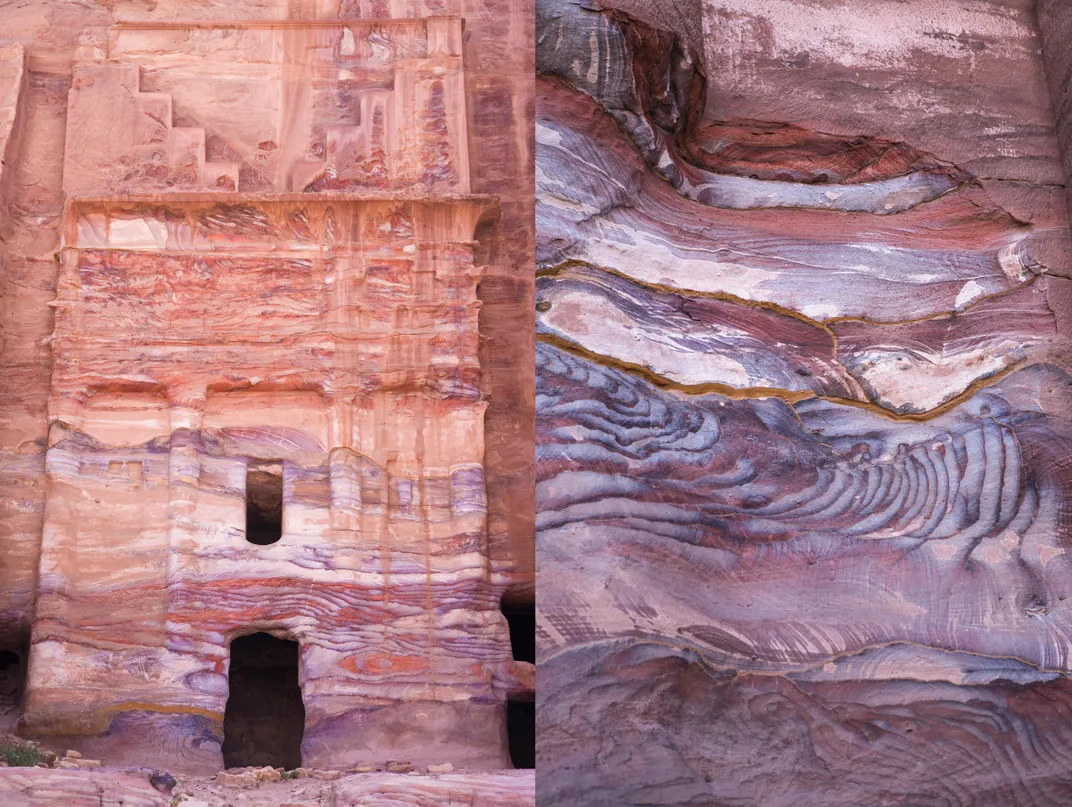
So much of Petra feels like a sly surprise that I became convinced the Nabateans must have had a sense of humor to have built the city the way they did. They were gifted people in many ways. They had a knack for business, and cornered the market in frankincense and myrrh. They had real estate savvy, establishing their city at the meeting point of several routes on which caravans shipped spices, ivory, precious metals, silk and other goods from China, India and the Persian Gulf to the ports of the Mediterranean. They had a talent for melding the dust and dirt around them into a hard, russet clay from which they made perfume bottles and tiles and bowls. They were expert artisans. And while it isn’t recorded in historical texts, they clearly appreciated the hallmarks of architectural showmanship—a good sense of timing, a flair for theatrical siting.
The most convincing evidence of this begins with the Siq, the main entrance to the city, a natural ravine that splits the towering rocks for almost a mile. It’s a compressed, confined space; its rock walls lean this way and that. Once you inch your way through it, you are spilled out onto a sandy apron and confronted with the most dramatic structure in Petra—Al Khazneh, or the Treasury, a cave more than a hundred feet high, its facade a fantastical mash-up of a Greco-Roman doorway, an Egyptian “broken” pediment and two levels of columns and statues etched into the sheer face of the mountain.
The Treasury wasn’t actually a treasury at all—it gets its name from the riches said to have been stored in the great urn atop the circular building at the facade’s center. The statues adorning the colonnaded niches suggest it may have been a temple, but most scholars think it was a tomb housing the remains of an important early king. (A favorite candidate is the first century B.C. Aretas III, who used the word Philhellenos on his coins—“friend of the Greeks”—which might explain the building’s Hellenistic flair.) Inside the cave there are just three bare chambers, today empty of whatever remains once rested there.
Perhaps the Nabateans placed this grand building here because the Siq served as a buffer to marauders, much like a wall or a moat. But I can’t help but think that they knew that forcing visitors to approach the Treasury via a long, slow walk through the Siq would make a perfect lead-up to a great reveal, designed to delight and astonish. The gradual approach also leaves the world with a timeless pun, because coming upon the Treasury this way makes you feel as if you’ve found a treasure at the end of a secret grotto.
Life in the Big City
Petra was a nexus of commerce and cultural exchange
When the Nabateans established their capital at Petra they ensured that it was well connected to booming trade routes: the Silk Road to the north, Mediterranean ports to the west, Egypt and southern Arabia to the south. With trading partners across the ancient world, the seat of Nabatean power was “the very definition of a cosmopolitan trade center,” writes the classicist Wojciech Machowski.
* * *
As Ahmed and I rode along, I could just make out in the distance the team from Virtual Wonders, who had spent the day flying a drone over the Great Temple, shooting high-resolution images of it from above. The company was formed in 2018 by three friends with complementary talents. Mark Bauman, a longtime journalist and former executive at Smithsonian Enterprises and National Geographic, knew the people in charge of historical locations like Petra and how to work with local authorities. Corey Jaskolski, a one-time high school dropout/computer whisperer (he eventually earned a graduate degree from MIT in electrical engineering), who has patented systems for impossible-seeming robotic cameras and 3-D scanning for use underwater, on land and from the air, would manage the technological challenges of image capture and digital modeling. Kenny Broad, an environmental anthropologist at the University of Miami, is a world-class cave diver and explorer for whom scrambling around a place like Petra was a piece of cake; he would serve as chief exploration officer. The three of them shared a passion for nature and archaeology and a concern with how to preserve important sites.
While outfits such as the Getty Research Institute and the nonprofit CyArk have been capturing 3-D images of historical sites for some time, Virtual Wonders proposed a new approach. They would create infinitesimally detailed 3-D models. For Petra, for instance, they would capture the equivalent of 250,000 ultra-high-resolution images, which will be computer-rendered into a virtual model of the city and its breathtaking structures that can be viewed—even walked through and interacted with—using a virtual-reality headset, gaming console or other high-tech “projected environments.” Virtual Wonders will share these renderings with authorities and other scholarly and educational partners (in this case, the Petra National Trust). Detailed modeling of this kind is at the leading edge of archaeological best practices, and according to Jordan’s Princess Dana Firas, the head of the Petra National Trust, the data will help identify and measure the site’s deterioration and assist in developing plans for preservation and managing visitors. “It’s a long-term investment,” Firas told me.
By the time I arrived in Petra, the Virtual Wonders team had scanned and imaged more than half of Petra and its significant buildings using an assortment of high-tech methods. A DJI Inspire drone—for which a military escort is required, because drones are illegal in Jordan—uses a high-resolution camera to collect aerial views, shot in overlapping “stripes” so every inch is recorded. Exact measurements are done by photogrammetry, with powerful lenses on 35-millimeter cameras, and Lidar, which stands for Light Detection and Ranging, a revolving laser mechanism that records minute calculations at the rate of a million measurements per second. When combined and rendered by computers those measurements form a detailed “texture map” of an object’s surface. All of this data will be poured into computers, which will need about eight months to render a virtual model.
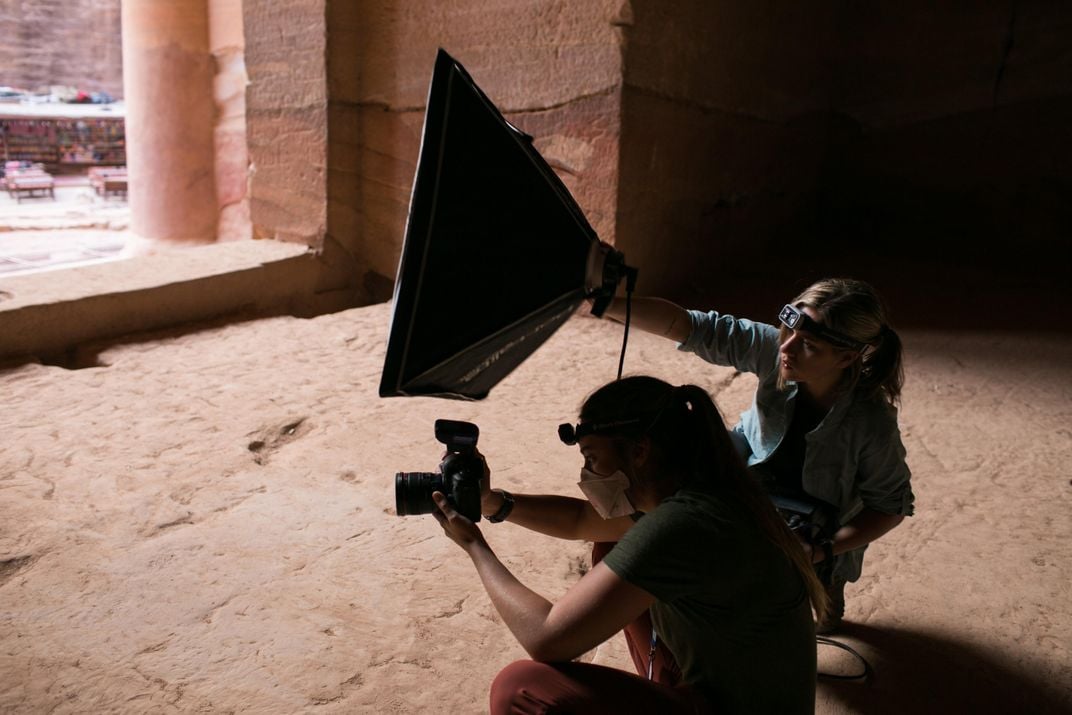
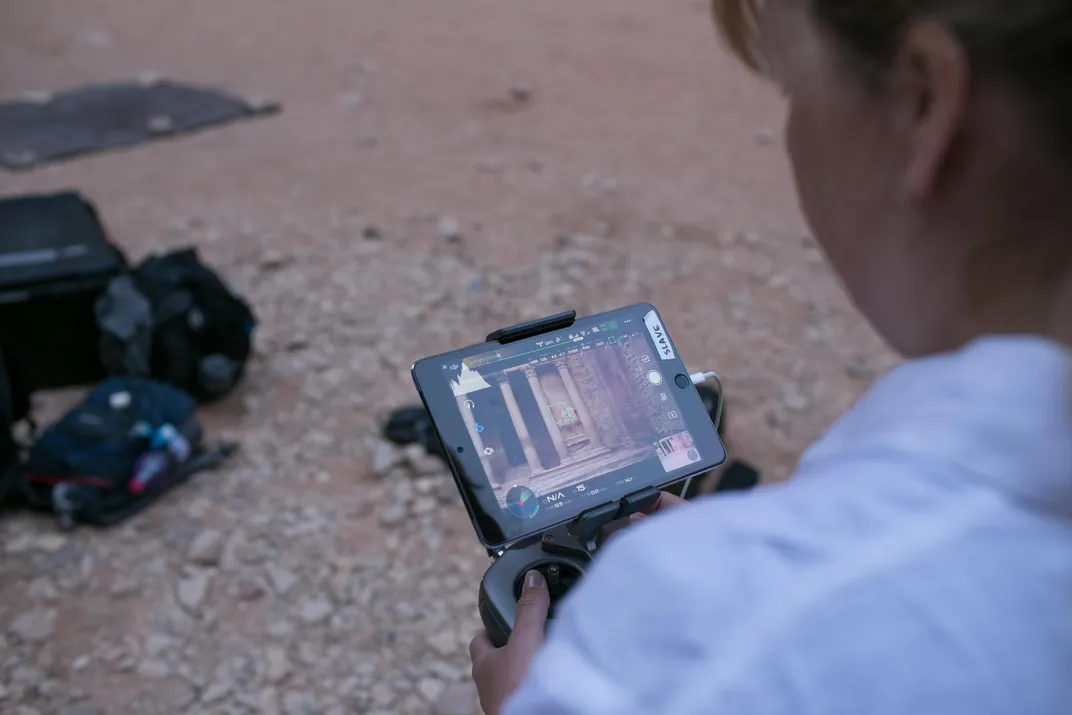
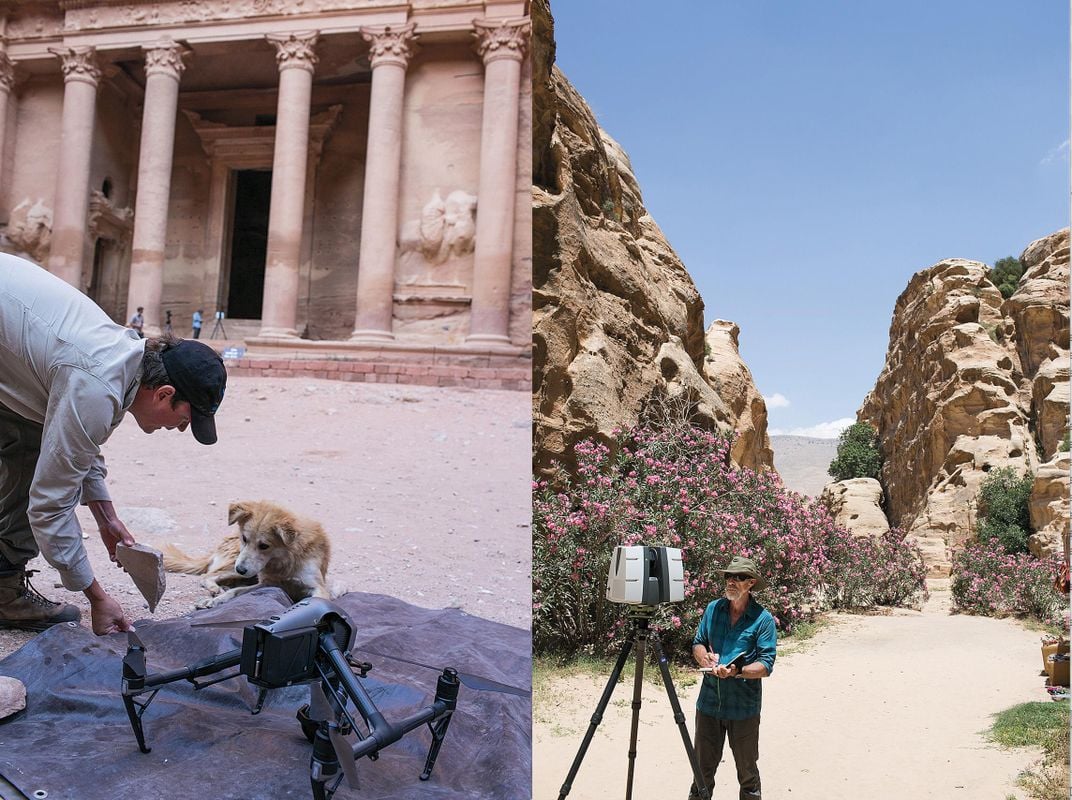
None of this is cheap. In Petra, the Virtual Wonders team hiked around with about a half-million dollars’ worth of gear. According to Bauman, the company’s hope is that the cost of the projects will be recouped, and exceeded, by licensing the data to film companies, game developers and the like, with a portion of the revenue going back to whoever oversees the site, in this case the Petra National Trust. This isn’t an idle hope. Petra is so spectacular that it has been used as a location in films, most famously Indiana Jones and the Last Crusade; countless music videos; and as a setting in at least ten video games including Spy Hunter, OutRun 2 and Lego Indiana Jones. If its approach succeeded, Virtual Wonders hoped to move on to similar projects around the world, and since I left Jordan the company has begun work at Chichen Itza, the Mayan city in the Yucatán. It has also scored a clear success with an immersive virtual reality exhibit titled “Tomb of Christ: the Church of the Holy Sepulchre Experience,” at the National Geographic Museum in Washington, D.C.
I left my donkey and crossed through the ruins of the flat valley to join the team on a ridge overlooking the Great Temple. “We’re shooting stripes,” Jaskolski called out as the buglike drone rose and jetted across the open sky toward the temple. Jaskolski’s wife, Ann, was monitoring the drone on an iPad. She reached out and adjusted the drone’s landing pad, a gray rubber mat, which was weighed down with a rock to keep the gusty breeze from toying with it. The drone made a burbling sizzle as it darted over the temple. Somewhere in the distance a donkey brayed. A generator coughed and then commenced its low grumbling. “We’re killing it!” Jaskolski called to Bauman, sounding a little like a teenager playing Fortnite. “I’m really crushing the overlap!”
Bauman and I hiked along the ridge to another building known as the Blue Chapel. A few crooked fingers of rebar stuck out of some of the rock—evidence that some clumsy restoration had been attempted. But otherwise, the structure was untouched, another remnant of the city that Petra once had been, a bustling capital, where lives were lived and lost; an empire etched in time, where the city’s carapace is all that remains.
/https://tf-cmsv2-smithsonianmag-media.s3.amazonaws.com/filer/ec/7a/ec7abaa7-b7b5-4113-b048-d79204bdb0e2/oct018_b09_petra.jpg)
* * *
On the far side of the valley from the Treasury, across the plain, Petra’s architects kept another great trick up their sleeve: Ad Deir, or the Monastery. This ancient temple is thought to have been dedicated to a deified Nabatean king named Obodas I, and possesses Petra’s largest carved facade. But the path there gives you no glimpse of it at all. For 40 minutes Ahmed and I clung on as our donkeys climbed up the steep path. I kept my eyes glued to the back of Ahmed’s head so I wouldn’t have to see the sheer drop-off along the edge of the trail.
As we made yet another turn with no building in sight, I began to wonder if I had misunderstood our destination. Even when Ahmed stopped and announced that we had arrived, there was nothing to see. The heat was getting to me and I was impatient. I grumbled that I didn’t see anything. “Over there,” Ahmed said, gesturing around a ragged rock wall. When I turned the corner, I was met with the full-frontal view of an enormous facade with an array of columns and doorway-shaped niches, almost 160 feet wide and nearly as tall, carved into a rocky outcropping. It was so startling and beautiful that I gasped out loud.
Like so many of the monuments here, the Monastery’s interior is deceptively simple: a single rectangular room with a niche carved into the back wall, which probably once held a stone Nabatean icon. The walls of the niche itself are carved with crosses, suggesting the temple became a church during the Byzantine era—hence the name. The Monastery is said to be the best example of traditional Nabatean architecture—simplified geometric forms, the urn atop a rounded building at the center. It is believed that the Monastery’s architect took inspiration from the Treasury but pointedly stripped away most of its Greco-Roman flourishes. There are no statues in the spaces cut between the columns, and overall it’s rougher, simpler. But out here, all alone, in front of a wide stone courtyard where Nabateans and travelers from across the ancient world came to worship or feast, the sight of the Monastery is profound.
I stared at Ad Deir for what felt like an eternity, marveling not only at the building but the way it had provided the exquisite pleasure of delayed gratification. When I returned to Ahmed, he was on the phone with his 2-year-old daughter, who was begging to get a new teddy bear on their upcoming trip to town. Ahmed has five other children. His oldest son, Khaleel, also works as a guide in the park. Khaleel had taken me earlier in the day to a ledge above the Treasury, a view even more vertiginous than the trail to Ad Deir. I needed several minutes before I could inch to the edge and appreciate the view. When I steadied my nerves and was able to peek out through squeezed eyes, I could grasp the monumentality of the Treasury—how it loomed, emerging out of the mountainside like an apparition, a building that wasn’t a building, a place that was there but not there.
What will it mean to create a perfect model of a place like Petra—one that you might be able to visit sitting in your living room? Will it seem less urgent to see Petra in person if you can stick on a pair of virtual reality goggles and make your way through the Siq, gawk at the Treasury, hike up to the Monastery, and inspect ruins that are thousands of years old? Or will having access to an almost-real version of Petra make it easier for more people to learn about it, and that, in turn, will make more people care about it, even if they never walk over its red rocks or slide their way through the Siq? The preservation aspect of projects like Virtual Wonders’ is undeniably valuable; it saves, for posterity, precise images of the world’s great sites, and will allow people who won’t ever have the opportunity to travel this far to see the place and experience it almost as it is.
But visiting a place—breathing in its ancient dust, confronting it in real time, meeting its residents, elbowing its tourists, sweating as you clamber up its hills, even seeing how time has punished it—will always be different, more magical, more challenging. Technology makes it easier to see the world almost as it is, but sometimes the harder parts are what make travel memorable. The long climb to Ad Deir, with its scary path and surprising reveal, is what I will remember, long after the specific details of the building’s appearance have faded from my memory. The way Petra is laid out means you work for every gorgeous vision, which is exactly what I imagine the Nabateans had in mind.
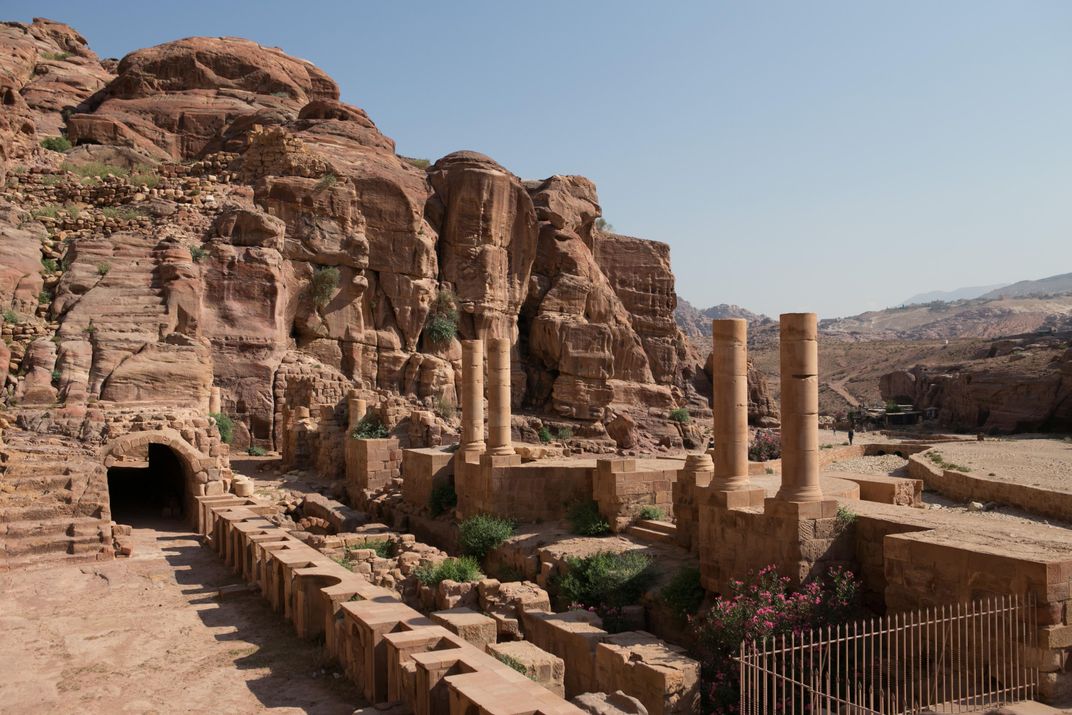
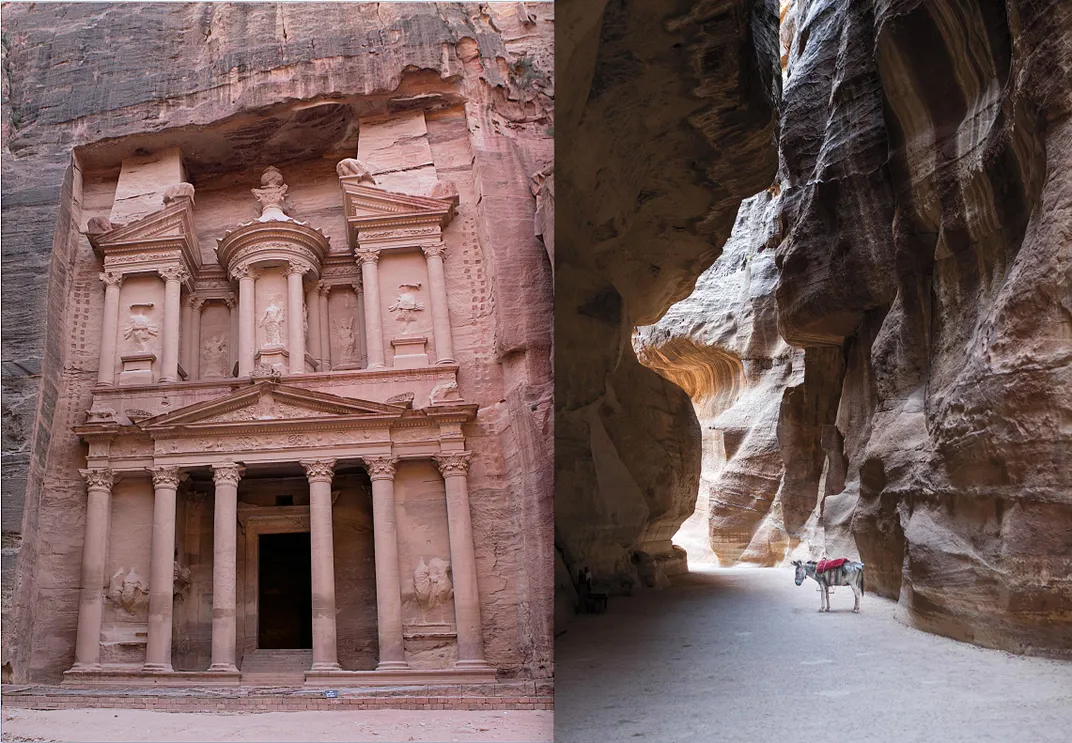
* * *
As soon as I left Petra, I found myself staring at the pictures I had taken and finding it hard to believe I had been there; the images, out of context, were so fantastical that they seemed surreal, a dream of a red stone city dug into the mountainside, so perfectly camouflaged that as soon as you drive the steep road out of the park, it seems to disappear, as if it were never there.
In Amman, where signs advertised this fall’s Dead Sea Fashion Week (“Bloggers and Influencers Welcome!”), my driver pulled up to the front door of my hotel and I stepped out, passing a sign directing Fashion Week attendees to the ballroom. The hotel had just opened for business—it was a glossy, glassy building that advertised itself as being in the heart of the new, modern Amman. But ancient Jordan was here as well. The entry was puzzlingly dark and small, with a narrow opening that led to a long hallway with walls that were akimbo, leaning in at some points and flaring out in others, with sharp angles jutting out. I inched along, dragging my suitcase and banging a corner here and there. Finally, the dark hall opened wide onto a big, bright lobby, so unexpected that I stopped cold, blinking until my eyes adjusted to the light. The young man at the reception desk nodded at me and asked if I liked the entrance. “It’s something special,” he said. “We call it the Siq.”
/https://tf-cmsv2-smithsonianmag-media.s3.amazonaws.com/filer/1f/ce/1fced74f-3198-498f-957b-a226031fdff6/oct018_b07_petra.jpg)